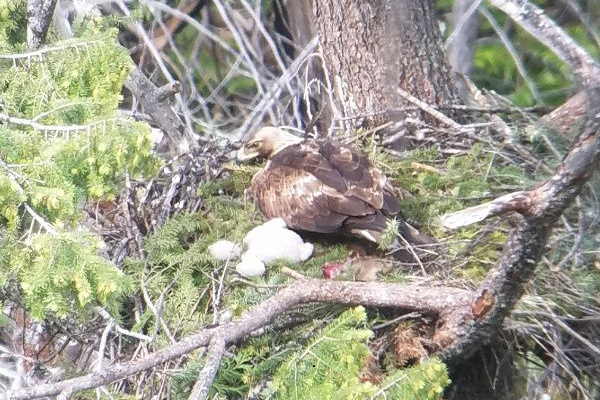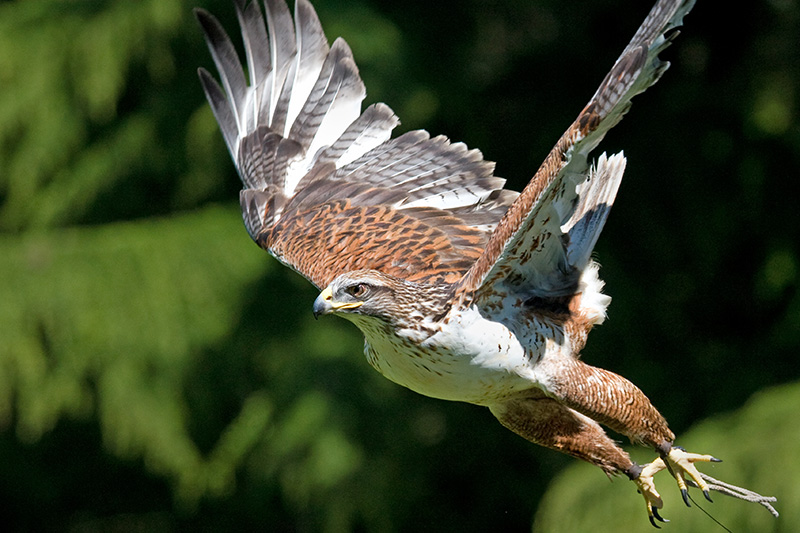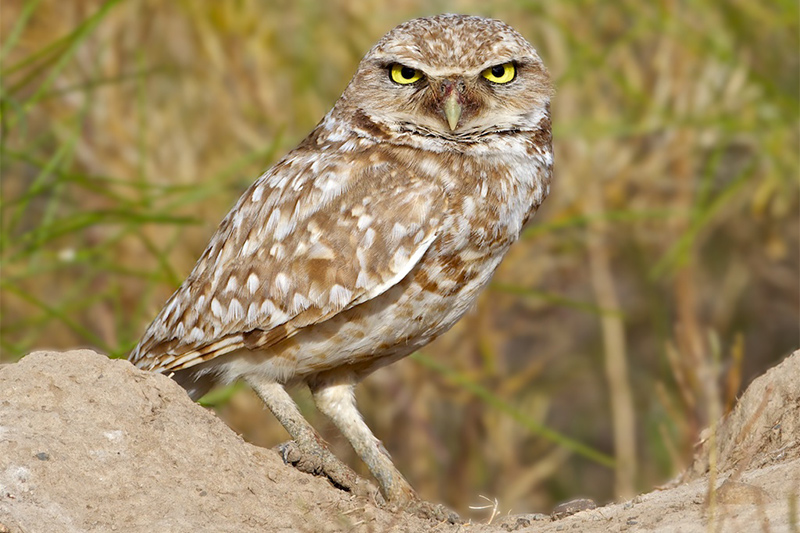NORTHWEST RAPTORS
RAPTOR ECOLOGY OF WASHINGTON'S SHRUB STEPPE
SOARING INTO THE FUTURE
When it comes to raptors (also called "birds of prey"), the shrub steppe habitats of the Columbia Basin of eastern Washington are home to some of the most amazing birds in the world. Golden eagles, short-eared owls, burrowing owls, prairie falcons, ferruginous hawks and rough-legged hawks make their home in this changing landscape—this project aids in the protection of raptors and the shrub steppe habitats they occupy by using expert technical and field assistance of Washington Department of Fish and Wildlife and Woodland Park Zoo staff. This work is helping to answer research questions important to ecology and protection of these raptors and their habitats, such as defining migration corridors, identifying sources of contaminants, or learning how raptors avoid wind turbines. We hope to spark interest in conserving shrub steppe habitats by fostering an appreciation of these charismatic resident raptors through educational programs and stories that highlight these incredible hunters.
ABOUT THE PROJECT
Due to continuing declines in migratory raptor populations in the shrub steppe—including golden eagles, ferruginous hawks, and short-eared owls—Washington Department of Fish and Wildlife scientists began research projects on raptors in eastern Washington in the 1990s. Woodland Park Zoo supports and participates in this field research to help scientists better understand population declines and manage habitat impacts, including lead pollution, fires and wind power development. In addition, the zoo has participated in raptor rehabilitation, giving us an opportunity to heal and share the stories of these rescued birds.
With support from Woodland Park Zoo, Washington Department of Fish & Wildlife (WDFW) researcher Jim Watson participates on the Western Golden Eagle Team, focused on planning and policy around lead contaminants, wind power mitigation, and eagle survival. Jim's long-term studies of the endangered ferruginous hawk have provided critical ecological information for recovering this species including migration patterns, home range use, and factors affecting mortality and survival.
Each spring, Woodland Park Zoo staff and volunteers join WDFW scientists to conduct raptor surveys. WDFW collaborates in statewide and multi-state programs to assess population trends of and threats to raptors such as short-eared owls, burrowing owls, and prairie falcons, resulting in data that directly influences conservation actions by agencies.
Good News for Washington's Shrub Steppe Raptors

Migration Routes
“Oma,” a golden eagle initially captured and radio-tagged in 2014 who winters in eastern Washington, successfully hatched her first eaglet in British Columbia in 2018, an international success story. We continue to monitor "Oma" on the same nesting territory. To date, she is one of five eagles WDFW has radio-tagged as juveniles and tracked to the time when they nested as adults.
Photo credit: Fran Iredale

Scientific Data
Over the years, this research project has radio-tagged 14 golden eagles to provide data that helps WDFW assess populations, activity within historical breeding territories, and how nesting eagles navigate around wind turbines. WDFW also monitors lead levels in eagles, ingested when they feed on the remains of animals shot with lead ammunition, to determine the threat that lead poisoning poses. More recently, two nestling ferruginous hawks and one nestling golden eagle were radio-tagged to provide additional data on juvenile survival and range use. This information provides understanding of factors that may affect the survival of young birds. By identifying those factors, and mitigating them, we can increase the number of young hawks and eagles that survive to reproduce as adults.

Field Observations
Each spring, WPZ staff help to conduct field observations of shrub steppe raptors. In past years, WPZ staff conducted observations at hawk nesting sites at wind turbine projects in north central Oregon. They observed nesting buteos (red tailed hawks, Swainson's hawks and ferruginous hawks) and recorded any interactions raptors had with wind turbines. More recently, WPZ staff conducted nesting surveys of prairie falcons and short-eared owls, making observations at locations where they historically nested. The data from these surveys is used by WDFW to better understand the threats these raptors encounter and to inform larger-scale surveys of these species in order to determine the status of their populations in Washington.
WHAT YOU CAN DO
Raptors of the Columbia Basin need plenty of prey, wide open spaces to hunt and nest, and a healthy habitat to survive. You can help make these things possible by taking a few simple actions at home:
- Lead contamination appears to be a serious threat to golden eagles. If you hunt, you can play a big part in stopping lead contamination from ammunition sources. Reduce your use of lead shot to eliminate lead in the environment. Talk to your local hunting supplier for lead-free alternatives.
- Climate change threatens raptors, specifically landscape loss due to more frequent and larger wildfires as well as heat waves that jeopardize young birds in the nest. Do your part to mitigate your carbon footprint at home and advocate for climate change actions at the local and federal level.
- Loss and degradation of shrub steppe habitat in Washington state’s Columbia Basin has reduced nesting sites and prey availability for ferruginous hawks and golden eagles. Get involved in habitat restoration and learn more about protecting these landscapes, especially if you are a community member in this area.
ABOUT RAPTORS
Ferruginous Hawks
These threatened hawks are a regal icon of the American west. They can be seen soaring over plains, prairie and dry grassland to swoop towards snakes, squirrels and rabbits in the sagebrush below. These raptors are migratory, coming to Washington to breed and raise their young in the arid shrub steppe habitat, and spending winters as far south as Mexico.
Ferruginous Hawk Fact Sheet
Ferruginous Hawk Postcard
Rough-legged Hawks
Rough-legged hawks are close relatives of the ferruginous hawk. Arctic populations fluctuate with rodent populations such as lemmings and voles. Soaring in cold arctic climates, these powerful raptors thrive in tundra regions, but spend winter farther south in areas like the Columbia Basin region. They are named for their feathered legs which is an adaptation for staying cozy in frigid arctic weather.
Golden Eagles
Golden eagles inhabit the shrub steppe area year-round and are a candidate for listing in Washington as threatened. They are about the same size as a bald eagle and prey mainly on rodents but may scavenge carrion (meat of dead animals). These magnificent hunters watch for prey from high perches or while soaring on air currents over slopes. They may mate for life and build large nests on cliff edges or large trees.
Short-eared Owls
Short-eared owls are often active during daylight, at dawn and dusk, and hunt low over fields and open grasslands. Their floppy wingbeat makes them appear much like a giant moth. Their prey consists of mostly rodents including voles, lemmings, mice and rabbits. When flirting, males spiral up into the air while making short, rapid hoots to woo a potential partner. Their nests are made in depressions in the dirt, built among tall grass or shrubs to keep the hatchlings hidden.
The decline of raptors in shrub steppe habitats in the Columbia Basin ecoregion has been most directly related to agricultural conversion that has resulted in loss of prey. However, lead contamination appears to be another serious threat, as are impacts from energy development, illegal poaching, electrocution and threats from climate change such as wildfires and excessively hot summer temperatures.
MORE WAYS TO HELP